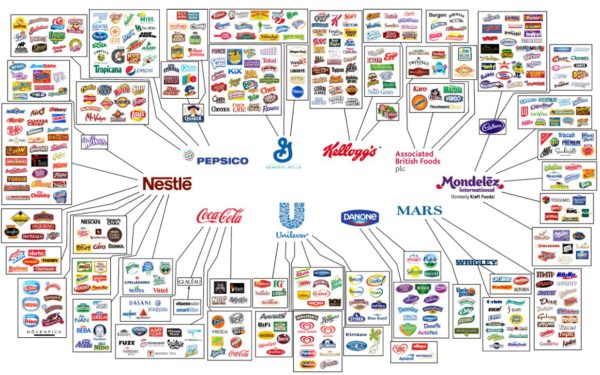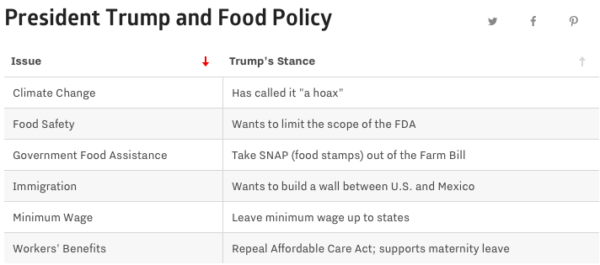Who owns the majority of food products on our shelves?

William Mougayar sent me this article. Very enlightening. Ten companies own the majority of the world’s food brand. Infographic tells it all.
 In addition…food policy is not exactly going to be moving forward. It will only line the pockets of these 10 companies even more.
In addition…food policy is not exactly going to be moving forward. It will only line the pockets of these 10 companies even more.


Comments (Archived):
I think food is one place where liberals like you and conservatives like me can come together and actually agree on a lot of issues. The Farm Bill is one of the most pork laden (no pun intended) bills that goes through Congress. The Ag lobby is the strongest lobby in the US-and has plenty of pals on each side of the aisle. Last year, 4000 pounds of tart cherries were dumped in upper Michigan because of bad government policy. Being a tart cherry pie lover, this is a travesty.Seriously, SNAP probably would be better off out of it and put into Health and Human Services. The infighting among government agencies for power is pretty amazing when you see it up close. For example, the commodity industry is regulated by the Dept of Agriculture (overseen by respective committees in the House and Senate). They are also regulated by the House Fin. Services and Senate Banking Committee. The Ag committees in Congress select and oversee the CFTC. The Fin Serv and Banking committees oversee the SEC. There is a lot of friction there. A lot.Glad you brought attention to the food thing. By the way, blizzard running through the upper Midwest today. You might want to buy some food or hop on that plane to France!
It is a sad picture indeed.I think we can fight back by educating the masses that these foods are not good for you. We don’t have to rely on the government for these changes. When consumers stop buying these horrible products, then these companies will start feeling the pains.I was in the Netherlands this past week, and was pleasantly surprised to see that junk foods have very little shelf space in food supermarkets and anywhere for that matter. At the check out counters, instead of lining up junk food like they do in NA, there were fresh mandarins (it’s the season), strawberries to go, bananas, etc. just small packages of fresh, wholesome foods. Add to this that the average person in Amsterdam cycles for 2.5 kms per day, and they apparently have the skinniest population with only 8% obese rate, which is very very low.Who are the grass root organizations and pundits that are fighting this via education, advocacy and lobbying?
There are definitely organizations that are pushing forward on this. Looks like the next four years (if we can make it that long) will have to rely heavily on private organizations to usher us through for intelligent change.
Let’s change policy and regulations so that we enable private orgs to lead change. Personally, ending subsidies is a passion of mine. Let’s see what happens. I bet organic gets even cheaper, and people make different choices in what they eat.
I think we can fight back by educating the masses that these foods are not good for you.You can’t fight an addiction with education once someone is addicted. The reason people have poor food choices is because it tastes good and is addictive. It helps them with the stress of modern life (the ones that aren’t eating for pleasure). And there are ‘triggers’ everywhere as well. Little know fact is that packaging and printing improvement (brought about by desktop publishing in the 80’s have added to this problem by creating more triggers).There was a diabetes commercial (I think it was for jardiance) and it shows diabetics driving by all sorts of food triggers and ending up with some healthy salad type meal. Meanwhile the commercial clearly indicates what a struggle it is. It literally has them licking their chops passing by fried chicken restaurants and similar. It’s really sad to see what is presented as suffering (because it must be suffering for those that have gotten into those eating habits I am guessing). The commercial was pulled from youtube as are most pharma commercials.
Well, one thing for sure is that the cost of health care goes up when people aren’t healthy. So, governments can play a role in education, as well as grass roots organizations.
not that simple my friend.the economics of the platform and the limitations on supply are the pertinent pieces here.
Hard to tell by looking at that graphic but I think many of those brands were actually acquired and at one point were small startups. They weren’t I am guessing developed in house by the giants (although some were obviously).Remember Snapple:https://en.wikipedia.org/wi…Snapple was founded by Leonard Marsh, Hyman Golden, and Arnold Greenberg in 1972 in East Meadow, Long Island, New York.[1] Their company, which was originally known as Unadulterated Food Products, was first conceived as a part-time venture to supply fruit juices to health food stores.Further:The Quaker Oats Company bought Snapple for $1.7 billion in 1994.[7] The company ran into problems and sold it to Triarc in 1997 for $300 million.[8] Triarc sold it to Cadbury Schweppes for $1.45 billion in September 2000.[9] It was spun off in May 2008 to its current owners.This doesn’t detract from the point you are making of course.
You might enjoy this one:http://arnoldwaldstein.com/…
great post.
is it true that the USDA has a food burning programme in place to keep market supply side under control? i think i read that somewhere recently. myth or gospel?
have never heard that before